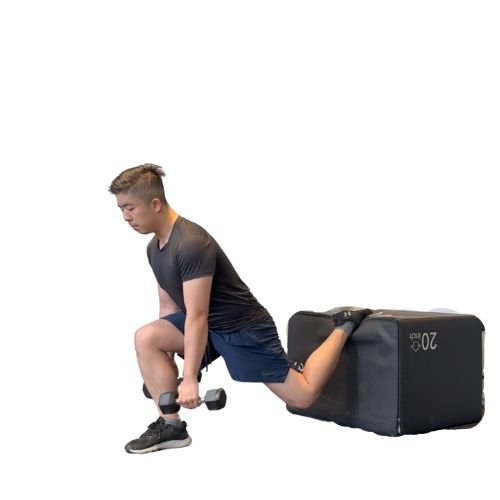Exercise Tutorial: Rear Foot Elevated Split Squat
Table of Contents
What Is a Rear Foot Elevated Split Squat
The Rear Foot Elevated Split Squat (RFESS), also known as the Bulgarian Split Squat, is a unilateral lower-body exercise that targets the quadriceps, glutes, hamstrings, and core.
The rear elevated split squat is similar to a regular squat, which consists of a bilateral eccentric contraction lowering down into a squat position, trying to get your femur (thighs) parallel to the ground, and concentrically coming back up. The difference is that instead of two feet, we are taking one leg off the ground, turning it into a unilateral exercise while raising the rear leg to further target our core and balance.
How to Do a Bulgarian Split Squat
Beginners should start off with a traditional split squat to get used to the movement, then progress to a Bulgarian Split Squat when ready.
Start by standing nice and tall with your feet slightly shoulder-width apart, standing a couple of inches in front of a bench, box, or any elevated surface that challenges you.
The leg that remains on the ground is called the stance leg (front leg in this case), and all the power should come from that leg. The rear leg will be placed on an elevated surface. Slowly lift either leg behind you and put it on the elevated surface.
Key reminders for the rear foot:
You can either have your foot flat on the surface or on your toes. Having the rear leg on your toes requires strength in your toes and a great amount of dorsiflexion and may not be comfortable or suited for some. Find what's comfortable for you.
Some people who have trouble with foot placement try the bottom-up approach. Get into the bottom position with your foot already on the bench, then pick your weights up if you are using dumbbells.
Keeping a tall chest and shoulders retracted to engage the posterior chain, lower yourself until the femur of your front leg is about parallel to the ground or your knee is about 90 degrees (90-degree knee flexion). Ensure your head, shoulders, and hips are in line.
Pushing through the front leg (the stance leg), bring your foot back up to starting position.
Rear Elevated Split Squat Muscles Worked
Calves (Gastrocnemius and Soleus)
Hamstrings (antagonist)
Hip Stabilizers
Rear Elevated Split Squats Alternatives
We all have different fitness levels, making each journey for a more fit and healthier lifestyle unique. There are many alternatives to the rear elevated split squat that still target similar if not all muscle groups.
The following below are alternatives you can try:
Bodyweight or Back Squat (bilateral)
Box Squats (unilateral or bilateral)
Split Squat (both feet on the ground)
Side Squat
Bulgarian Split Squat Variations
So you are ready to give yourself more of a challenge to further progress your workout and see more physiological benefits, try the following variations:
Dumbbell Rear Elevated Split Squat
Single Dumbbell Rear Elevated Split Squat (challenges core more)
Barbell Rear Elevated Split Squat
Isometric Rear Elevated Split Squat
Front Foot Elevated Split Squat
Zercher Rear Elevated Split Squat (advanced)
Something as simple as changing your tempo, especially during the eccentric (lowering) portion, can significantly increase the intensity and overall awareness as well.
Benefits of Rear Elevated Split Squats
Glute Development: This exercise greatly challenges Glute Maximus and Medius, leading to amazing glute gains if done correctly and progressed.
Balance and Coordination: By lifting a leg off the ground, you're putting more emphasis on one side of the leg while trying to keep your hips squared. This challenges your core and can help with core stability.
Performance: Almost in any sport you watch, there is a period where an athlete's power is needed from one side of their body quickly. Isolating one side can help increase your muscular power so you can jump, punch, sprint, and kick better and faster.
Spine alignment: At times, people have lower back issues or spinal pain. By putting the load to the sides of your body, you put less load on your spine, allowing you to still get the muscular development you would if you were to do a back squat.
Correct Imbalances: Imbalances are altered length-tension relationships on each side of a joint. This can be very compromising when trying to do sports or daily activities. By isolating one side of the leg, we are able to correct those imbalances.



